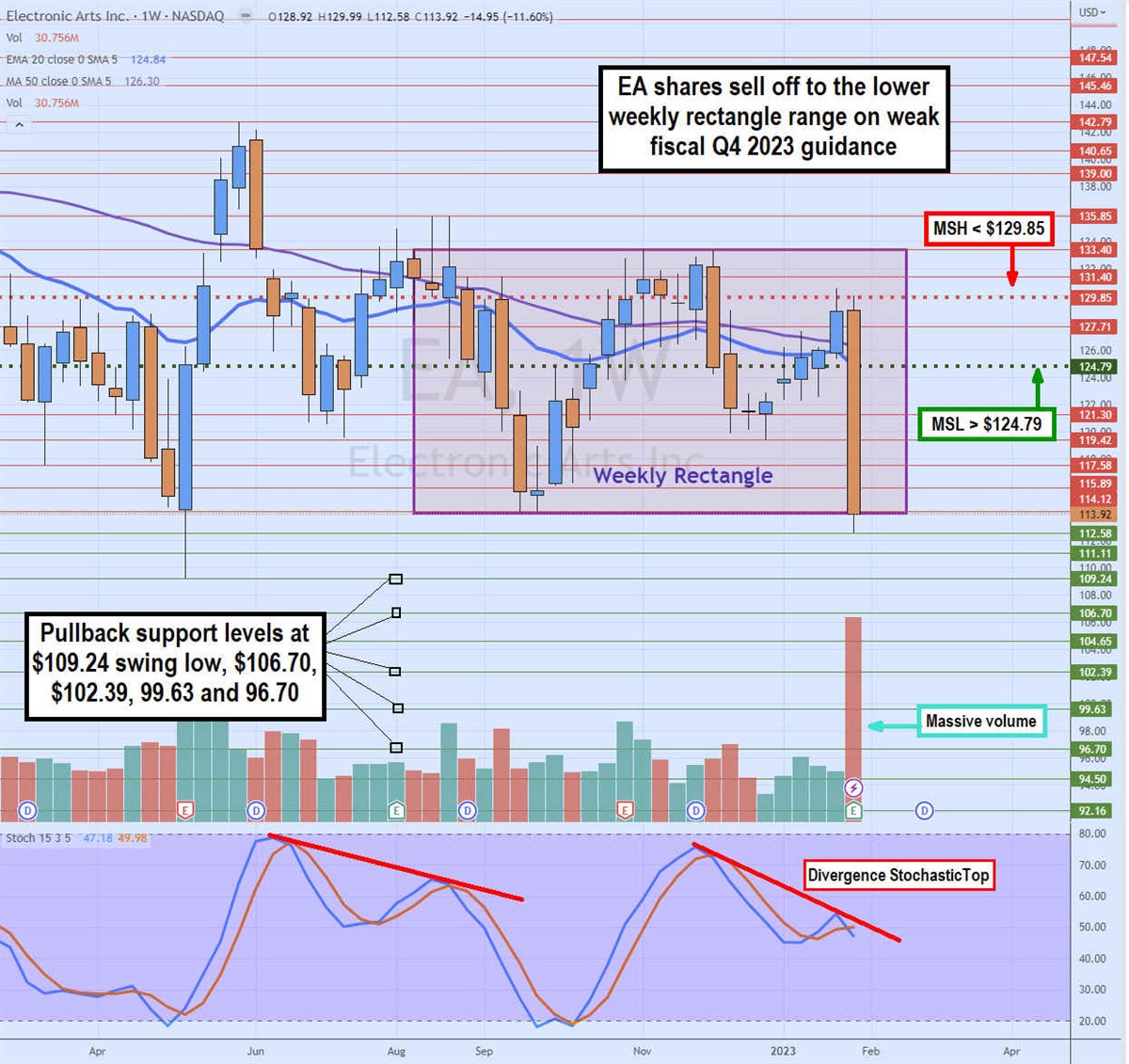
Video game publisher Electronics Arts (NYSE: EA) stock has been chopping in a 20-point weekly rectangle trading range since August 2022. While the Company was able to expand its player network during the COVID pandemic, its revenue and earnings growth also peaked during the height of the lockdown mandates.
The Company has been experiencing normalization, as evidenced by the continued booking decline. Electronic Arts severely lowered its fiscal Q4 2023 top and bottom line guidance as it pushed back the release of Star Wars Jedi: Survivor to fiscal Q1 2024.
While the game is still coming out, it will release on April 28, 2023. This means its Q1 2024 may reflect a jump from the release. Unfortunately, this did little to calm investors as shares collapsed (-12%) afterward.
Macroeconomic headwinds continue to hurt NYSE: GME">sales and net bookings, which has been a running theme among video game publishers like Microsoft Co. (NASDAQ: MSFT), Roblox Co. (NASDAQ: RBLX), and Sony Co. (NYSE: SNE) heading into 2023.
Out with FIFA, In with EA Sports FC
Electronic Arts stated that EA Sports FIFA 2023 is on pace to be the biggest title in franchise history, delivering record engagement in fiscal Q3 2023. However, they have parted ways with FIFA selling over 325 million copies in nearly three decades under the FIFA license.
Electronic Arts will not be paying licensing fees to FIFA anymore after FIFA 2023, nor will it have rights to the World Cup. It will rebrand its franchise under the name EA Sports FC.
FIFA will be seeking to auction its license among video game publishers. EA Sports FC (Futbol Club) will start its independent franchise with FC 2024, featuring over 19,000 players, 700 teams, 100 stadiums, and 30 leagues which have all been licensed.
EA Sports FC has exclusive rights to the Premium League, Serie A, LaLiga, Bundesliga, and MLS. This move away from FIFA is expected to save EA over $150 million in licensing fees.
Softness Abounds
On Jan. 31, 2023, Electronic Arts released its fiscal third-quarter 2023 results for December 2022. The Company reported an earnings-per-share (EPS) profit of $0.73, beating analyst estimates of $0.50 by $0.23. Revenues fell (-9.1%) year-over-year (YoY) to $2.34 billion, falling short of the $2.5 billion consensus analyst estimates.
Net bookings fell (-1%) YoY to $7.146 billion for the trailing twelve months. Live services and other net bookings rose 4% YoY, comprising 75% of total net bookings. The EA player network grew to over 650 million in the quarter.
Electronic Arts CEO Andrew Wilson commented, “While our teams delivered for our players, the current macro environment impacted Q3 results. As we navigate the short term, we're focused on building for the long term and remain confident about our future. With amazing talent, proven IP, and growing player network, EA is operating from a position of strength."
Severely Lower Guidance
Electronic Arts cut its Q4 fiscal 2023 EPS to $0.05 to $0.20 versus $0.74 consensus analyst estimates. Revenues are expected between $1.675 billion to $1.775 billion versus $2.24 billion consensus analyst estimates. This sent shockwaves as shares tumbled (-15%) on the guidance.
The drop in guidance was due to the delay of its highly anticipated Star Wars Jedi: Survivor games pushed until April 28, 2023, which falls into the fiscal Q1 2024 quarter. It is also ending development early for two of its mobile gaming titles reflecting softness in mobile gaming as indicated by Take-Two Interactive Software Inc. (NASDAQ: TTWO) in its prior quarter.
Analysts Reactions
Bank of America cut its rating on EA stock to Neutral from Buy with a price target of $130. Jeffries left their Buy rating unchanged but noted that the rare miss is a sign that Electronic Arts is also starting to succumb to industry headwinds. Analyst Andrew Uerkwitz commented, "Game delays, increasing game complexity, uncertain consumer behavior, and general macro [economic issues] have been wreaking havoc on the video game industry.”

Weekly Rectangle Breakdown Attempt
The weekly candlestick chart on EA shows a rectangle trading range on the verge of a breakdown after its earnings reaction on heavy volume. The rectangle formed in August as shares sold off from $133.40 to a swing low near $113.92.
As the weekly stochastic bounced back up through the 20-band, shares could accelerate higher after triggering the weekly market structure low (MSL) breakout above $124.79. Shares retested $133.40 by November 2022 before triggering a weekly market structure high (MSH) selloff on the breakdown below $129.85.
The weekly MSH held firm resistance on the pre-earnings run-up before shares collapsed on the release. The weekly 20-period exponential moving average (EMA) resistance falls again at $124.84, followed by the weekly 50-period MA resistance at $126.30. The weekly stochastic forms a divergence top again as each stochastic crossover down forms at a sequentially lower band.
This is foreshadowing a breakdown of the weekly rectangle range. Pullback supports in the event of a breakdown are at a $109.24 swing low, $106.70, $102.39, $99.63, and $96.70.






